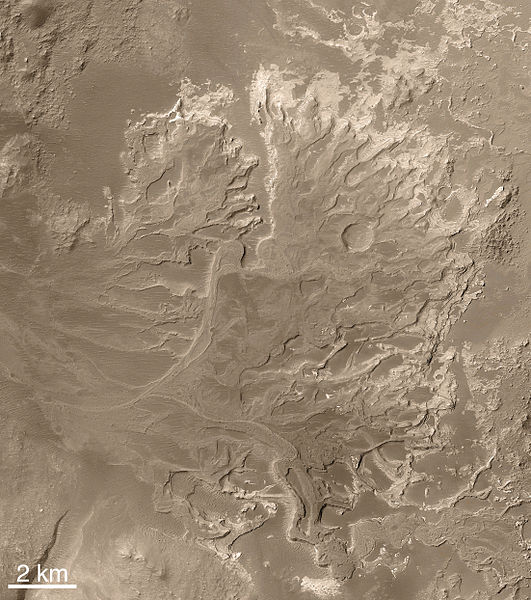Valley networks are branching networks of valleys on Mars that superficially resemble terrestrial river drainage basins. They are found mainly incised into the terrain of the martian southern highlands, and are typically - though not always - of Noachian age. The individual valleys are typically less than 5 kilometers wide, though they may extend for up to hundreds or even thousands of kilometers across the martian surface.
Branched valley network in Thaumasia quadrangle, as seen by Viking Orbiter. Field of view is roughly 200 km across.
Part of a valley network near Warrego Valles, seen by THEMIS. Length of image is roughly 50 km.
Finer scale valley networks near Candor Chasma, seen by HiRISE (click to zoom). Field of view is roughly 3.5 km across. Surface the valleys are cut into appears to be eroding back.
The Eberswalde delta, seen by MGS. Note the meanders with cutoffs, now seen in inverted relief.
The geology of Mars is the scientific study of the surface, crust, and interior of the planet Mars. It emphasizes the composition, structure, history, and physical processes that shape the planet. It is analogous to the field of terrestrial geology. In planetary science, the term geology is used in its broadest sense to mean the study of the solid parts of planets and moons. The term incorporates aspects of geophysics, geochemistry, mineralogy, geodesy, and cartography. A neologism, areology, from the Greek word Arēs (Mars), sometimes appears as a synonym for Mars's geology in the popular media and works of science fiction. The term areology is also used by the Areological Society.
Mars as seen by the Hubble Space Telescope
Viking Orbiter 1 view image of Valles Marineris.
Mars Orbital Laser Altimeter (MOLA) derived image of Planum Boreum. Vertical exaggeration is extreme. Note that residual ice cap is only the thin veneer (shown in white) on top of the plateau.
HiRISE image of simple rayed crater on southeastern flank of Elysium Mons.








